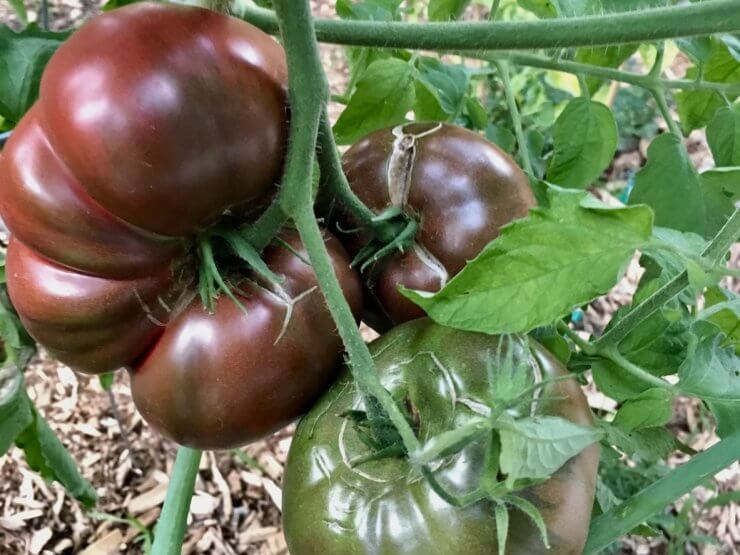
Ah, the Cherokee Purple tomato—part heirloom, part legend, and wholly delicious. This distinctive tomato is said to trace its roots back to the Cherokee Nation, passed down through generations before it gained fame among home gardeners. Its deeply hued skin, ranging from purple to dark red, and its luscious, smoky-sweet flavor make it a standout at the dinner table and a showstopper in the garden.
Cherokee Purple tomatoes burst onto the gardening scene in the late 20th century, thanks to seed saver Craig LeHoullier, who received them from a fellow gardener. Word spread quickly, and today, they’re a beloved variety among tomato enthusiasts nationwide. Home gardeners love the fruits for their rich, complex flavor, perfect for slicing into thick, juicy slabs. Cherokee Purple has even gained a reputation as a “tomato connoisseur’s dream.”
Discover 10 top tips for growing, harvesting, and enjoying fruits, vegetables, herbs and more from your home garden—when you access the FREEBIE How to Grow a Vegetable Garden, right now!
A Growing Plan for Success
Selection:
Look for seeds or seedlings from reputable garden centers or seed companies specializing in heirloom varieties. Check for healthy, robust plants with no signs of disease or wilting.
Planting:
Cherokee Purple tomatoes thrive in full sun, so choose a location with at least 6–8 hours of daily sunlight. These plants are versatile and adapt well to:
- Containers: Use a large container (at least 15 gallons) with drainage holes.
- Raised Beds: Ensure nutrient-rich, well-draining soil.
- In-Ground Gardens: Amend soil with compost for fertility and aeration.
Plant seedlings after the last frost, spacing them 18–24 inches apart. Bury them deeply, leaving only the top leaves exposed, to encourage strong root development.
Growing Tips:
- Support: Use sturdy cages or stakes to support their vigorous growth.
- Watering: Keep the soil consistently moist but not soggy. Avoid overhead watering to reduce the risk of fungal diseases.
- Feeding: Apply a balanced tomato fertilizer or compost tea every 2–3 weeks.
- Pruning: Remove suckers (small shoots between the main stem and branches) to focus energy on fruit production.
Harvesting:
Cherokee Purple tomatoes are ready to harvest when they have a rich, deep purple hue with green shoulders and yield slightly to gentle pressure. The flavor is at its peak just before full ripeness.
Special Tips & Tricks for Cherokee Purple Success
These unique heirlooms require some specific care to reach their full potential. Here are expert techniques to help you grow the best Cherokee Purples possible:
- Early Season Care: Start seeds indoors 6-8 weeks before your last frost date. Unlike other varieties, Cherokee Purples benefit from slightly cooler germination temperatures (65-70°F) to develop strong root systems. Use a heating mat only until germination, then move to cooler conditions.
- Light Management: While they need full sun, Cherokee Purples can be sensitive to intense afternoon heat. In hot climates, consider planting where they’ll receive morning sun and light afternoon shade. Their dark coloring makes them especially susceptible to sunscald in very hot conditions.
- Soil Preparation: These heavy feeders thrive in rich, slightly acidic soil (pH 6.2-6.8). Prepare beds with plenty of compost and aged manure. A unique trick: add a handful of crushed charcoal to each planting hole – it helps prevent soil diseases that these heirlooms can be prone to.
- Support Considerations: Cherokee Purples produce large, heavy fruit – often up to 1-1.5 pounds each. Use sturdy, heavy-duty cages or strong stakes. The Florida weave method isn’t recommended as the fruit weight can stress the vines.
- Pruning Protocol: Unlike determinate varieties, Cherokee Purples need strategic pruning. Remove suckers below the first fruit cluster, but maintain enough leaf cover to prevent sunscald on the dark fruit. Leave more foliage than you would with other varieties to protect the fruit.
- Watering Wisdom: These tomatoes are prone to cracking due to their thin skin and high sugar content. Water deeply but less frequently once fruit begins to develop. Maintain consistent soil moisture to prevent splitting, especially after rain.
- Harvest Hints: The trickiest part of growing Cherokee Purples is knowing when to harvest. Don’t wait for them to turn completely dark – harvest when the shoulders are still green but the bottom is a deep brick red with dark green/purple overtones. The color should be halfway up the fruit.
- Disease Prevention: Cherokee Purples are more susceptible to disease than modern hybrids. Practice strict crop rotation (don’t plant tomatoes in the same spot for at least 3 years), and mulch with red plastic mulch to boost growth and deter soil-borne diseases.
- Saving Seeds: If you plan to save seeds, remember that Cherokee Purples are excellent candidates for seed saving as they’re stable heirlooms. Choose your best-performing plant and save seeds from its best fruit for next year’s crop.
These tomatoes might require extra attention, but their incredible flavor – often described as having hints of wine, smoke, and sweetness – makes them worth every effort.
Cherokee Purple Tomato in the Kitchen
Cherokee Purples might not look picture-perfect like grocery store tomatoes, but their imperfect appearance hides what many consider to be the perfect tomato flavor. Be patient with them, and they’ll reward you with some of the most delicious tomatoes you’ve ever tasted. They’re especially prized for sandwiches and eating fresh, though their rich flavor also makes them excellent in sauces and salsas.
The culinary uses for Cherokee Purple tomatoes are as boundless as a gardener’s imagination. Here are some standout ideas:
- Tomato Basil Mozzarella Salad (Caprese Salad): Thick slices paired with fresh basil, mozzarella, and a drizzle of balsamic glaze. Also try our Heirloom Tomato Caprese Casserole.
- BLT Sandwiches: These juicy tomatoes elevate the classic sandwich to gourmet status.
- Pasta Sauce: Their smoky sweetness creates a rich, flavorful sauce for pasta dishes.
- Roasting: Roasted Cherokee Purples bring out an earthy, caramelized depth.
- Fresh Salsa: Their vibrant flavor shines in salsas or bruschetta toppings.
- Grilled Tomatoes: Toss them on the grill with a sprinkle of salt and olive oil for a smoky side dish.
Cherokee Purple tomatoes aren’t just a garden crop—they’re a flavorful connection to history and an irresistible centerpiece for any meal. Whether you’re growing them in containers, raised beds, or a sprawling backyard garden, these tomatoes promise to reward you with their exceptional taste and captivating story.
For more tips and tricks, check out our Everything Tomato Gardening Guide, where you’ll find expert advice on growing, harvesting, and enjoying the best tomatoes ever. Let’s make this growing season your tastiest yet!
If you grow Cherokee Purple tomatoes, what are your tips and tricks?
Discover 10 top tips for growing, harvesting, and enjoying fruits, vegetables, herbs and more from your home garden—when you access the FREEBIE How to Grow a Vegetable Garden, right now!





I doubt I’ll ever see the Cherokee tomato here in South Africa, and that is a pity. The description you provided intrigues me. I’d love to grow these things.
I’m excited. I’ve started my seeds I’ve been collecting over winter!